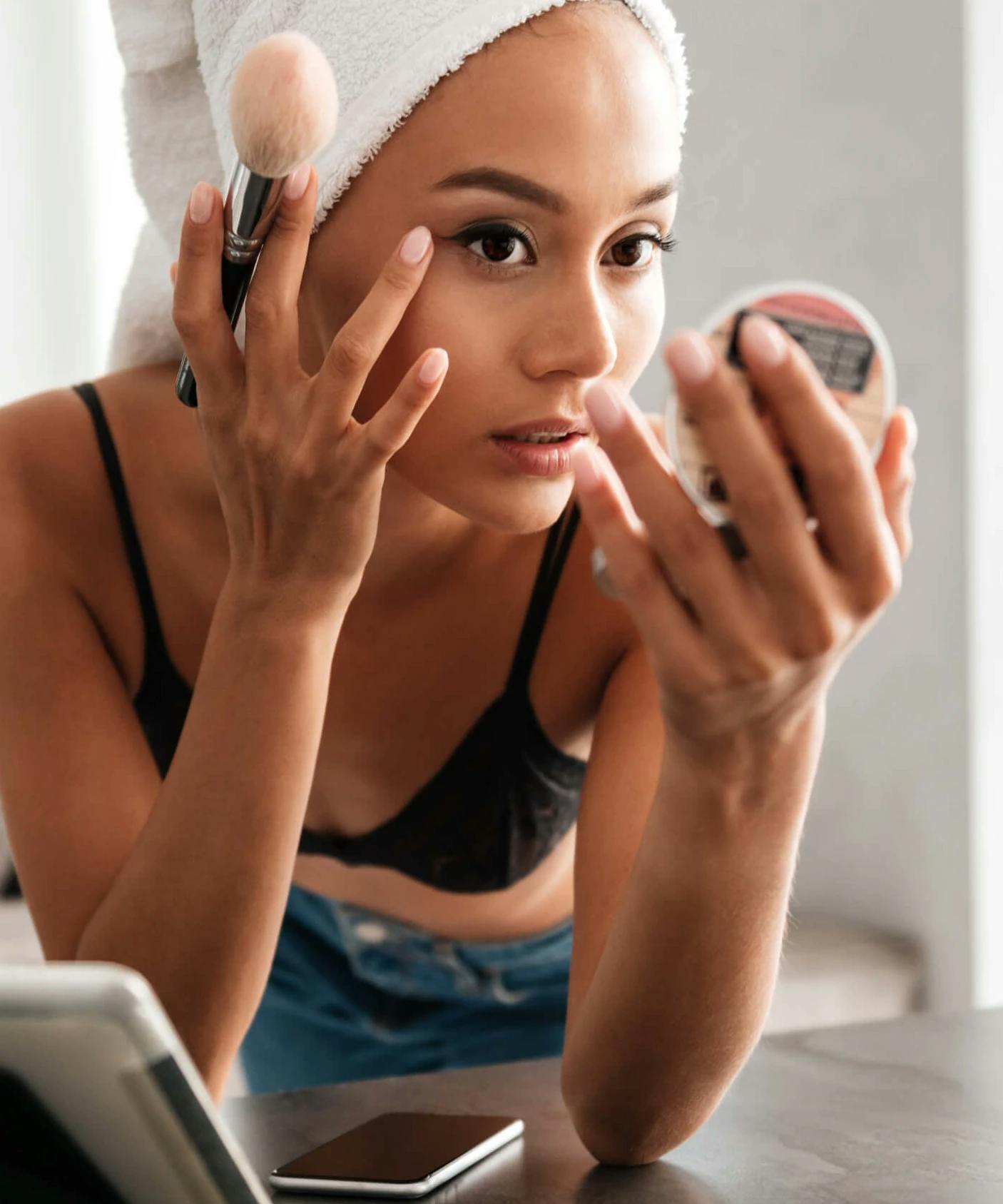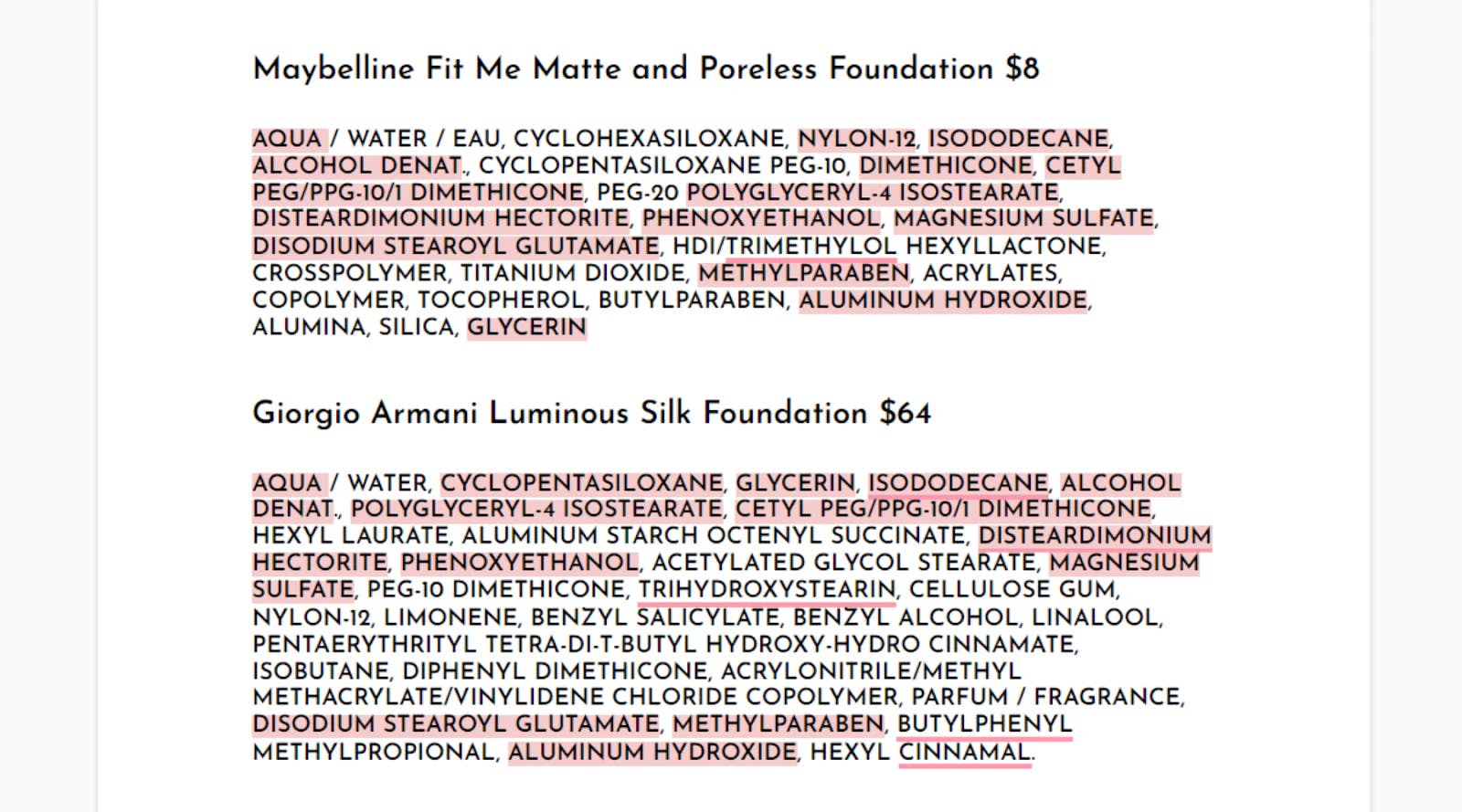Most Makeup Is Made By The Same Five Companies. So Is Top Dollar Foundation Worth It?
Most beauty products are owned by the same mega-companies. So does it make sense to shell out top dollar for the fancy stuff when the formula could be the same as lower-tier makeup?

The Top Brands in the Beauty Sector
As consumers, we like to think we're making a conscientious decision when buying from a certain brand, especially when it comes to something as personal as beauty products.
However, one thing that can make this a little complicated is the fact that over 180 beauty brands fall under the massive umbrellas of five huge manufacturers.
Here are the companies that own the beauty aisle:
L'Oréal
L'Oréal has the most brands on this list, with a total of 39 beauty brands, including major staples like Lancôme, Maybelline, Urban Decay, Garnier, Essie, NYX, Biotherm, Yves Saint Laurent, and The Body Shop. It also has high-end skincare and haircare brands, including Pureology, La Roche Posay, and SkinCeuticals.
Coty
Coty is yet another big baller in the beauty industry, with 33 total brands under its belt. It owns many big-name products, including OPI Products, Rimmel, and CoverGirl, and it's behind celebrity toiletries from Katy Perry, David Beckham, Beyoncé, and Kylie Jenner, among others.
Shiseido
Shiseido, which itself is a well-known skincare brand, particularly famous for its vast range of sunscreens, has around 30 other beauty brands underneath it. Some of those are also makeup brands, including BareMinerals, Nars Cosmetics, and Laura Mercier. The vast majority are brands that might not be recognized in the U.S., including Japanese brands Majolica Majorca, Ettusais, Maquillage, and Aqualabel.
Over 180 beauty brands fall under the massive umbrellas of five huge manufacturers.
Estée Lauder
Estée Lauder Companies is in charge of 24 brands, and some of its holdings include makeup and fragrances by fashion brands like Michael Kors, Tom Ford, Tommy Hilfiger, and Tory Burch, each of which has its own cosmetics or toiletries line alongside a few very popular beauty brands, including Smash Box, Bobbi Brown, Clinique, La Mer, and MAC Cosmetics.
Johnson & Johnson
The last major brand is on the smaller side, but what it lacks in quantity it makes up for in name recognition. Johnson & Johnson owns nine beauty brands, including ultra-popular skincare lines such as Aveeno, Neutrogena, Clean & Clear, and RoC.
Does This Mean All Foundations Are the Same?
While all of these companies and brands focus on formulating various skincare and makeup products, the few complexion products almost all of them carry are a foundation, a concealer, or a BB cream.
So, this fact alone begs the question of whether all the complexion products are the same since they’re carried by one manufacturer? The answer is a little more complicated than a simple yes or no.
Cosmetic chemist Nick Morante says that no matter what form the foundation comes in (cream, liquid, or spray), it contains the same main ingredients – emollients, colorants, and fillers. The base of a foundation is usually water, oil, or wax. Talc, which helps color spread evenly and makes the product go on the skin smoothly, is the most common filler. Pigments include iron oxides and titanium dioxide in various red, yellow, and black shades to help recreate natural skin tones.
Therefore, when you take a look at most of the foundations these major companies carry, all of them will have these base ingredients, making them look fairly similar to one another. However, even though the ingredients might appear the same, it's only the base ingredients that are actually the same.
For example, let's compare the Maybelline Fit Me Matte and Poreless Foundation ($8) with Giorgio Armani Luminous Silk Foundation ($64). Both brands are owned by L'Oreal, and although some of the ingredients are the same, the two foundations are very different from one another.

Marked in pink are the ingredients found in both foundations, a.k.a the base ingredients, while many others are clearly different.
This means the foundations will differ in some important details such as finish, the longevity of wear, scent, and even color, as some foundations are known to oxidize and turn orange after a couple of hours.
This could be due to the quality of the ingredients used in the foundation but also because the formula doesn't necessarily get along with your skin, and the chemistry between the two is making the foundation change colors.
It's important to note that a high-end foundation might not be a better option for everyone, and some people might find their holy grail in the form of a foundation that costs $10.
The point is that foundations, even though they might look the same, are actually different, and while this usually reflects in the cost in most cases, choosing a foundation depends entirely on what works best for you.
Things To Consider When Buying a Foundation
Besides wanting to support a certain brand because of what they stand for, the causes they contribute to, their transparency and honesty on how they source their ingredients, or even simply because of their prices, here are a few important things that you should consider when buying a foundation.
Your Skin
It doesn't matter how much you like or dislike a brand when the most important thing a foundation needs to do is work for your skin.
Not all foundations are the same, and most of them can be a hit or a miss. That's because we all have different skin, and our skin behaves differently when exposed to various ingredients.
Therefore, even if you have oily skin, not all mattifying foundations will work for you. Some will make your face super matte, dry, patchy, and dehydrated, while others might not be mattifying enough. This is why you have to put your skin first when buying a product you wear daily.
Foundations will differ in finish, the longevity of wear, scent, and even color.
Your Skin Concerns
The next important thing you need to pay attention to when buying a foundation is your skin concern, as foundations have the potential to seriously aggravate some skin concerns.
If you have skin prone to acne, you definitely need to look for something lightweight that won't clog your pores and lead to even more breakouts.
On the other hand, if you have dry skin, you should stay away from a mattifying foundation as this will not only make every pore and line even more visible but will actually dehydrate and irritate your skin even more.
The Ingredients
The texture of the foundation depends on the ingredients present in the formula, such as alcohols, silicones, emollients, etc., which give the foundation a particular finish, making it suitable for various skin types.
For example, a foundation that contains alcohol denat is likely to have a mattifying finish, thus making it more suitable for oily skin types. On the other hand, foundations that contain more emollients and oils are usually creamier and are typically more suitable for dry skin types.
There are also foundations with active ingredients such as salicylic acid that double as a treatment for those with acne-prone skin.
Other Products in Your Beauty Regimen
A foundation's wear and performance also depend on other products in your beauty regimen. Some foundations might wear great and stay put for many hours when applied over a silicone primer, while others will start to separate and get oily after only a couple of hours. Therefore, it's important to take your entire beauty regimen into consideration when choosing a new foundation.
What's Worth the Investment?
As a good rule of thumb, if you wear a product every day and it lasts six months or longer, then it might be a good idea to invest. You don't need to feel bad about spending $60 if the foundation works for you and you use it daily.
You also don't need to spend hundreds of dollars trying to find a more affordable option because this is also something that happens when people want to find something better or cheaper than what they already have.
If you’ve found your foundation holy grail, simply stick to it.
Chances are that if you’re trying to replace a foundation you already love, many others won't compare to it, and you will end up spending more and more to find a better or a cheaper one. If you’ve found your holy grail, simply stick to it.
Complexion products such as foundations, concealers, and face powders that work for your skin are worth investing in because they usually last longer.
What's Better To Save On?
There are makeup products that you can definitely save money on because most of the time they don't last long, and some affordable brands have excellent products that aren't as personalized as a foundation is.
Eye products such as mascara and eyeliner definitely belong to this category as these usually last around three months and should sometimes be changed even more frequently to minimize the risk of infections. Lipsticks also belong to this category as there are so many lipstick shades to choose from and many affordable formulas work just as well as expensive lipsticks. Lastly, blushes are also products that you can save money on as some brands like Milani and Essence have a great range that goes for less than $10.
Closing Thoughts
Foundations are a very personal makeup product; therefore, choosing the perfect one comes down to what works best for you.
It certainly doesn't mean that a high-end foundation will be better than a drugstore option; however, even though they contain similar ingredients, the formulas are, in most cases, different from one another.
Love Evie? Let us know what you love and what else you want to see from us in the official Evie reader survey.